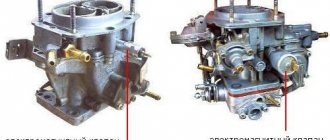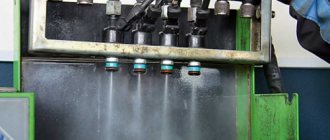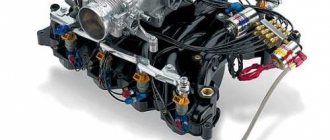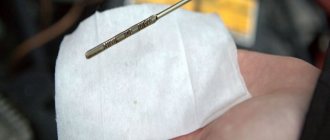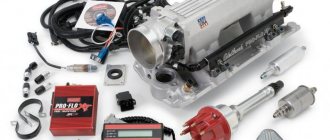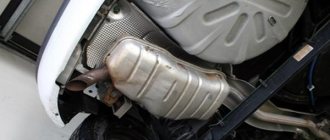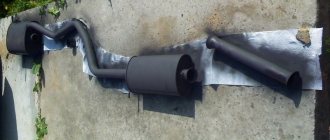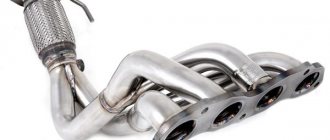Where does water come from in a car exhaust system?
The reason for this is condensate - a liquid that has changed from a gas state due to cooling or compression. Its appearance is due to temperature differences: a muffler heated from the inside is not cooled as intensely as from the outside. In this case, moisture is formed only after the engine is stopped. As soon as the car stalls, dewdrops will begin to settle in the exhaust pipe. In winter, the accumulated condensate also freezes. So the ice build-up gradually increases, forming a traffic jam in the car muffler.
Physical processes of condensation formation
The composition of the fuel is the basis from which moisture appears inside the exhaust pipe. Gasoline is a mixture of light hydrocarbons. When burned, they produce a variety of gaseous substances, including water vapor. Regardless of the quality of the fuel, there will always be moisture in the muffler. But “premium” gasoline emits less water than cheap gasoline. At a certain air temperature, these vapors settle. This is how condensation forms: the exhaust pipe quickly cools from the outside, but the warm air remains inside for a long time.
Where does water come from in a car muffler exhaust pipe?
Here, in principle, there is nothing special to tell. Everything has been studied and explained a long time ago. It turns out that the combustion of hydrocarbons, which is gasoline, produces water and combustion by-products. In order not to bother you with formulas, take a look at the figure below and you will see what our fuel turns into approximately in the combustion chamber of the engine.
From all this it follows that even if you have high-quality gasoline and there is no water in the tank, then during combustion you will still get water, or rather water vapor, in the exhaust pipe. Since the same gases escape from the combustion chamber. Now the process is completely simple - condensation of vapors on the metal walls of the exhaust pipe. All this leaves us no chance that the exhaust system will “live” without water.
Now, having realized that we can’t get away from water, we need to solve the question - how can we not at least get rid of it, but minimize its impact on the exhaust system? The problem of corrosion of the components of the exhaust system is known to everyone, especially to car enthusiasts of domestic cars.
Here you need to understand that there is such a thing as the dew point. In fact, these are conditions consisting of humidity and temperature when the gas becomes saturated, that is, for a given temperature it can no longer contain a certain volume of water vapor, which means that condensation begins to form on surfaces in contact with the steam.
The warmer the air and the colder the surface with which it comes into contact, the greater the likelihood that condensation will “fall out”. In fact, if this condition is met, water will form in the muffler while the muffler metal is still cold. Afterwards, when the muffler warms up, the likelihood of water forming in it decreases.
That is why, to reduce the likelihood of excess moisture forming in the exhaust pipe, it is better to warm up the car well, that is, drive not to work and back, but sometimes somewhere further away and for a longer time.
Now that we have understood the processes of water formation in the muffler and how it can be dealt with, let’s talk about the dangers of excess water that can accumulate in the exhaust system of a car.
What are the dangers of accumulated water in the exhaust system of your car?
We have already talked about corrosion of the exhaust system, which does not “like” excessive moisture at all. Thus, an increased water content in the exhaust system will lead to its elements corroding and becoming unusable ahead of time.
The second, no less pleasant phenomenon that you may encounter when water forms in the exhaust system is the formation of ice impassable plugs in the exhaust system during the cold season. Gradually growing ice jams can “crush” the engine to the point where it stops starting altogether.
(ice extracted from the exhaust pipe of a car during the cold season)
Well, in this case there is no need to mention the reduction in power, since this is quite logical.
So, the formation of water in your muffler (exhaust system) is inevitable. We also mentioned ways to get rid of excess moisture in the exhaust system. Now, we can only hope that you will find the optimal balance for yourself, when there is not so much water in your muffler, and the mileage will be optimal for you, and not too high.
The last thing I would like to say is that the phenomenon of water in the muffler is somewhat akin to the manifestation of oil foaming on an unheated engine, when the engine also does not heat up, or rather does not warm up for long enough.
Why does a lot of water collect in the muffler?
Noticing condensation dripping from the exhaust pipe, an inexperienced car owner either panics or is perplexed. Rushing to the nearest service station is not the smartest idea. Several factors contribute to the accumulation of moisture in the inside of the pipe. You need to understand them in more detail:
- driving in winter - the difference in temperature outside the muffler and inside it makes itself felt;
- infrequent use of the car - short short trips are fraught with increased condensation;
- modern exhaust gas purification – their design entails side effects.
When driving in winter
The cold season is the best condition for the formation of condensation in the muffler. The air temperature outside the exhaust pipe is much lower than inside it. So the moisture does not evaporate, but settles in a liquid state. Automatic warming up of the car partially solves the problem with condensation. But moisture still remains on the cold components of the exhaust system, because the idle speed is not so high as to blow it out with a stream of gases. Therefore, water settles inside the muffler, accumulating with each new heating.
When using the car infrequently
The shorter the trips, the worse the muffler warms up, which means less intense evaporation of moisture. It will settle inside the exhaust pipe in larger volumes than during long-term operation. Car owners who make long trips experience less difficulty with condensation in the muffler. The same cannot be said about those who use their iron horse only for short “home-work-home” forays.
In cars with modern exhaust gas cleaning systems
Due to the catalyst (emission system), condensation can flow while driving the car. A lot of substances come out of the cylinders and are sent to the exhaust manifold. The process is accompanied by the release of nitrogen oxides, carbon monoxide, unburned hydrocarbons, carbon dioxide, oxygen and water. Only the last three elements are harmless to humans. All the rest go to the car's catalyst, where they are oxidized by platinum and palladium. This is how carbon dioxide and water vapor are formed. The latter remains inside the muffler.
Where does condensation come from in the muffler?
Condensation in the muffler accumulates gradually and unnoticeably, and after some time a noticeable amount of water accumulates in the muffler. When water begins to splash from the exhaust pipe, it is already visible to the naked eye. And the water can gurgle when the car shakes, this is all a rather unpleasant sensation.
Most often, water begins to accumulate in winter; it is during this period that it often changes its state from water to ice, from ice to water, and from water to gas. In summer, water can also accumulate in the muffler, except that it does not turn into ice, but condensation drips from the muffler as before. You can simply change the muffler if you have the money for it, but simply changing the muffler corrugation is enough.
At its core, condensate is water that was recently in a gaseous state. The fact that condensation appears on the exhaust pipe is a normal natural phenomenon. Condensation may also appear in the interior and other parts of the car. Sometimes it is harmless, but sometimes it can cause damage to some parts of the car, especially metal ones, which can simply rust and rot.
Heavy condensation from the exhaust pipe can splash even in a new and working car. Condensation appears in the muffler precisely after the engine is turned off. The inside of the car cools down more slowly than the outside, so moisture begins to accumulate in the muffler. And if there is a motor outside, then this moisture freezes. If the car is constantly in motion and driven every day, then condensation will always accumulate on the exhaust pipe and inside the pipe.
Condensation also drips from the muffler, especially often in cars with automatic start in the winter, because the exhaust pipe completely warms up within 20 minutes and the ice has time to melt, but has not yet had time to evaporate, but when you press hard on the gas, water begins to fly out of the exhaust pipe along with exhaust gases.
Therefore, if you notice that water is dripping from the exhaust pipe, then there is nothing to worry about and there is no need to panic and go to a service center.
To prevent water from accumulating less and leaving the exhaust pipe faster, there are the following methods:
- fill with high-quality fuel;
- insulate the muffler with a heat insulator that does not ignite;
- leave the car in the garage, if you have one;
- or make a hole in the muffler, then water will flow through it, but this is undesirable, because corrosion will develop even faster at the hole and, as a result, the muffler will not be quiet.
But all the same, in winter condensation will form in the muffler, no matter how you look at it, because the temperature difference will always remain. The muffler will last about 10 years even if moisture accumulates in it. When it rusts and you choose a new muffler, it is better to immediately buy a more expensive one with anti-corrosion protection.
Therefore, dealing with condensation in the exhaust system is a waste of time. And those who are worried whether this water from the muffler will harm the car should not worry - this condensate will not cause harm.
Is condensation in a car dangerous?
Moisture settled in the muffler is a sign of proper operation of the internal systems of the car. Although such a phenomenon does not pose a radical danger, it would be thoughtless to turn a blind eye to it. The main reason for this is corrosion. Experts at domestic service stations claim that exhaust gases are no less aggressive than condensate. But water in a car muffler is still a potential threat, just like any metal liquid. The same applies to the gas tank, engine, and interior - in these places moisture sometimes accumulates in the same volumes as in the muffler.
The design of the exhaust system of modern cars
Modern vehicles are equipped with a more sophisticated exhaust gas exhaust system that traps most harmful substances:
- Exhaust manifold - combines exhaust gases from all cylinders into one stream;
- Catalyst. Introduced into the system relatively recently, it consists of a special filter that traps harmful substances and a sensor that monitors the level of gas purification. On cheaper car models, a flame arrester can be used instead of a catalyst, which reduces the cost of the vehicle;
- Resonator. In this element of the exhaust system, gases reduce their temperature and noise level;
- Muffler. The very name of the system element indicates its purpose - to reduce the noise level emitted by the vehicle to the maximum permissible limit.
How to prevent liquid from appearing in the exhaust pipe
Whether it’s a luxury car or an old car, this will not protect you from the laws of physics; condensation forms in all of them. The same applies to the quality of gasoline - there will be moisture in all brands, albeit in different volumes. But if water gets into the muffler, then effective recommendations should be followed. Tested by time and practice, they will help get rid of condensation:
- Store the car inside the garage when cold weather sets in. Many car owners prefer to leave their vehicles in the cold, not wanting to waste time walking from home to garage - in winter this is a gross disrespect for their car. If you park it in a warm room at night (for example, in a garage), then in the morning it will take less time to warm up.
- Auto warm-up This feature is available in most modern cars. It is important to set it up correctly so that the muffler warms up along with the car. Otherwise, there is no guarantee that even when this system is activated, the exhaust pipe will not be clogged with icy condensate. This applies to both cars with injectors and carburetors - however, the latter warm up more slowly.
- Pay attention to the parking spot. If the car is parked on a slope towards its muffler, then water flows out of it faster.
- Arrange at least weekly long trips. This is an effective prevention against the formation of an ice plug from frozen moisture.
- Insulate the exhaust pipe of a car if there is neither a garage nor a heating function. Non-flammable heat insulators or liquid heating are suitable for this.
- Change gas station. Poor quality fuel also contributes to the formation of condensation inside the muffler.
- Drill a tiny hole in the resonator. An old and controversial method that ensures the free flow of water. The disadvantage of this method is that this same hole will serve as a catalyst for the development of corrosion.
Is it possible to reduce the amount of liquid in the exhaust?
The intensity of condensation inside the exhaust system is practically independent of the make and model of the car. It should be understood that a small amount of water in the pipe is normal. The exception is a situation when liquid flows like a river due to a cylinder head gasket failure.
Since you can't control the chemical reaction of gasoline burning to release water vapor, try to combat condensation. What is needed for this:
- reduce the temperature difference between the heated surface of the pipe and the surrounding air;
- reduce the humidity of air in contact with hot flues;
- create conditions for natural evaporation of condensate.
There is only one way to meet these requirements - store the car in a warm, tightly closed garage equipped with exhaust ventilation. Less moisture will fall out of the heated and drier air, and thanks to the positive temperature, the condensate will evaporate during parking and be removed through the hood. Please note that it will not be possible to completely get rid of water droplets from the muffler.
Almost every motorist faces the problem of condensation in the muffler and, as a result, leakage of water droplets from the exhaust pipe. This phenomenon, which is relevant both in winter and summer, often leads car owners to suspect that there are problems with the systems. At the same time, the formation of steam and leakage of liquid, being a normal physical process, does not always indicate a malfunction. Condensation can collect on new cars in the same way as on those with decent mileage, and in most cases does not cause any damage, so most often there is nothing to worry about. But if the leaking liquid has an unusual color or clouds of white smoke come out of the pipe, then this is a reason to think about it and go for diagnostics.
Water from the muffler: reasons
There are 2 reasons why water drips from the muffler. Condensation can appear from the outside - when snow and rain penetrate into car systems. In the second case, moisture forms directly in the exhaust, since any engine runs on a fuel-air mixture.
A hot engine produces steam, the amount of which increases due to sudden temperature changes.
Condensation can also accumulate in other vehicle systems:
- In the engine itself. White deposits at the neck are traces of condensation.
- Near the valves (due to gasket damage).
- In the lubrication system (due to refrigerant).
- In the fuel tank (due to the use of low-grade fuel).
Try to keep the tank filled to the brim and park the machine indoors. Then the risk of moisture in the tank will be minimal.
Moisture inside the car is a big problem, because it may not reach the muffler, remaining invisible.
The liquid will significantly accelerate the wear of the elements. Therefore, it is worth regularly checking the engine compartment and undergoing maintenance in a timely manner.
The presence of condensation in the fuel tank can be determined by difficulty starting the engine or by engine interruptions. Moisture gets inside the tank along with low-quality fuel.
When refueling, look at the price of gasoline or diesel fuel. If it is significantly lower than the market price, be wary and do not rush to rejoice. The octane number is easily increased synthetically, using additives. Therefore, it is better to go to proven, branded gas stations.
Experienced motorists try to always keep the fuel tank full. This is not a whim, but an opportunity to avoid the appearance of condensation even with low-grade fuel. There is simply no room left for moisture inside the tank. Conversely, regular partial refueling helps retain moisture in the gas tank and other car systems.
There is no less trouble with condensation in the engine. It comes here from the fuel tank. A sign of a problem is excessive heating of the motor. You need to inspect the car for leaky gaskets or valves. If there is moisture on the internal combustion engine itself, this can be determined by grease stains on the engine body. The oil mixes with hot air, evaporates, and settles as condensate.
You can get rid of moisture in the tank and engine by using chemistry - special enzymes dissolve in water. Compounds are formed that easily burn out during engine operation without causing damage to the engine installation.
Water is more likely to form in cars with modern exhaust gas treatment systems. Condensation may leak from the muffler while driving. It occurs in the catalyst, which oxidizes platinum, palladium and other harmful compounds coming from the engine. As a result of the reaction, carbon dioxide and water vapor are formed, which remains on the walls of the pipe.
Self-diagnosis
A novice car enthusiast does not know why water drips from the muffler and what causes this phenomenon. There are several ways to determine what causes an increased amount of liquid in the exhaust system of a car:
- You should warm up the vehicle's engine well and attach a sheet of thick, white paper, for example, from a sketchbook, to the muffler. Then let it dry and look at the marks left by the condensation - if they are minimal, no big deal. When a thick circle remains on the paper, there is an oil leak from the engine. It's time to go to the service station and solve the problem with the gaskets or cylinders.
- Problems with the main components of the engine are also indicated by a characteristic smell under the hood or a specific coating of condensation on the parts of the vehicle.
- In modern cars, oil and antifreeze sensors are located on the dashboard. A sudden overconsumption of these materials indicates probable problems in the vehicle systems. Here, too, you cannot do without the help of professionals.
It is important to remember that cheap fuel means its low quality. Modern industry has long been producing various additives that increase the octane number of gasoline and diesel fuel. The more additional chemicals the car owner sends into the gas tank, the worse it is for the vehicle itself.
What is the danger of water in the muffler?
Natural transparent condensation is not a problem if there is little of it. It’s just water - its accumulation, on the contrary, indicates the serviceability of all systems. Things get worse if the moisture has an unusual color and thick black smoke appears.
Danger No. 1 - condensation can turn into ice. This threatens to rupture the muffler or resonator. In addition, when water freezes, important channels connecting the motor to other systems become clogged. Therefore, it is very difficult, almost impossible to start the car.
Danger #2 is corrosion. The internal cavities of the exhaust system quickly rust. For example, on the first VAZ cars, the resonators and pants rotted in almost 3 years, although they were made of durable steel. With a stainless muffler of foreign cars, things are somewhat better, but condensate can react with sulfur dioxide (present in the exhaust of any internal combustion engine), form acid and corrode the metal in 1-2 years.
Moisture is especially dangerous for a diesel unit. Here, fuel lines and fine filters easily freeze, and interruptions in the operation of glow plugs occur even in summer.
The color of the condensate coming out of the muffler is important. Yellow (or red) color indicates an antifreeze or oil leak. Black condensate is the use of low-quality fuel with additives. Also, black color indicates carbon deposits. The green tint is a consequence of the high sulfur content in gasoline.
Blue smoke from the exhaust pipe
When oil gets into the engine cylinders, blue smoke begins to come out of the car's exhaust pipe. It is often confused by car enthusiasts with white smoke or steam, since the blue color is unsaturated. At the slightest suspicion of blue discoloration in the exhaust gases, you should pay attention to oil consumption, which seriously increases.
The problem with oil getting into the cylinder occurs due to poor sealing of the parts of the cylinder-piston group, for example, wear of the oil scraper rings or valve stem seals. The problem may be accompanied by a loss of power in the car and an increase in crankcase gas pressure.
Blue smoke is typical for new cars and cars that have been parked for a long time. It does not indicate a malfunction, and the cause of its occurrence is the “grinding in” of parts to each other. If the car is new from the showroom, the engine parts take shape, adjusting to work together. When blue smoke comes from the exhaust pipe of a car that has been sitting idle for a long time, it is caused by corrosion of some elements of the cylinder-piston group.
( 413 votes, average: 4.51 out of 5)
How to check the vacuum brake booster
How to check current leaks in a car
Related Posts
How to get rid of water in the muffler
Moisture should not actively accumulate inside the muffler. You can avoid its formation by following these recommendations:
- Increase the engine warm-up time if the engine has automatic warm-up. You can use a separate liquid heater if the muffler does not have time to heat up.
- Do not leave your car outdoors in winter.
- Use quality fuel. The low grade is all water.
- Place the car at an angle with the front end down after starting the engine. This method will reduce the intensity of corrosion on metal walls.
- Insulate the muffler (especially important for cold areas). Any non-flammable heat insulator can be used.
It is worth making long trips at least once every 30 days (preferably in winter or autumn). This will make it possible to warm up the car and its exhaust system well. An hour-long drive on the highway at high speeds is the best way to remove excess moisture from the silencer. Short trips around the city do not give such an effect. This, on the contrary, is a destructive factor - the condensate will only have time to thaw and turn into water.
How to eliminate the problem of coolant getting into the cylinders
Troubleshooting a malfunction in the power unit in which coolant gets into the engine crankcase:
Most likely : the cylinder head gasket is broken. It is necessary to dismantle the head and replace the gasket with a new one.
The car enthusiast can fix this problem himself; he just needs to know in what order the nuts on the cylinder head are tightened, and you need to have a dynamometer, since this operation is performed with a certain force.
The cylinder itself is damaged, for example, a crack has appeared. This problem cannot be easily solved; most likely, the unit will have to be replaced.
Therefore, remembering the life axiom: there is nothing worse than having to redo something for someone else, we recommend finding a good motor mechanic and letting a professional diagnose the engine. After all, high-quality repair of a power unit depends on a professional determination of the cause of the malfunction - this is an axiom. And from the one who does the repairs.
We hope that the information about the causes of white smoke from the exhaust pipe, which we shared in this article, will help car enthusiasts keep their “iron horses” safe and sound. And if a malfunction has already occurred, then you already know the correct algorithm of behavior to ensure that the vehicle serves for a long time and with high quality.
Did you like the article?
Share the link with your friends on social networks:
We also have interesting e-mail newsletters, subscribe ! (once a week)
